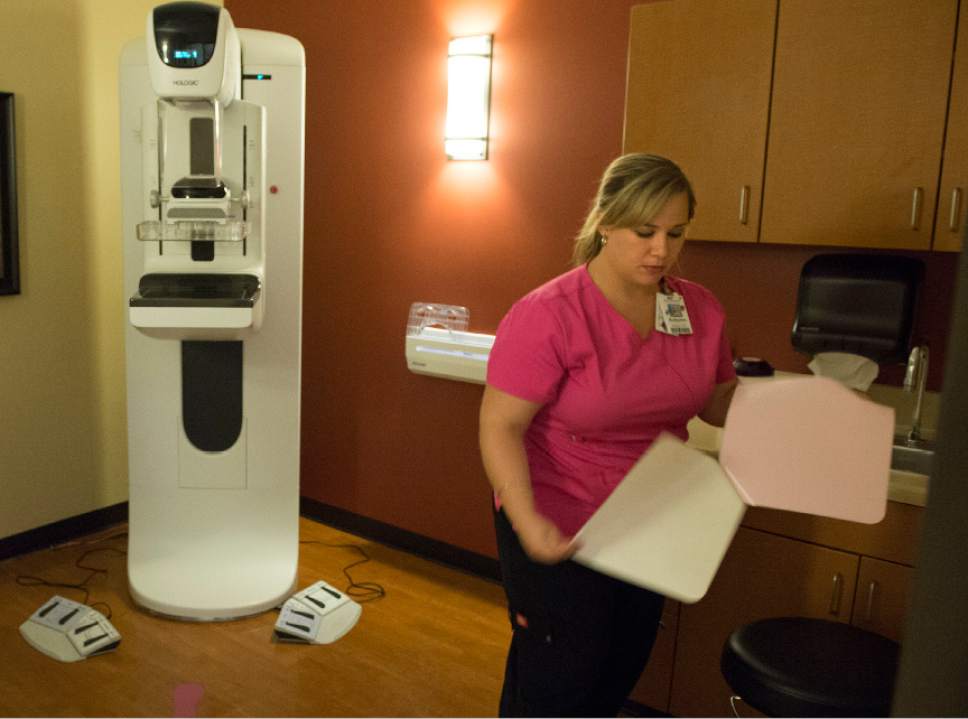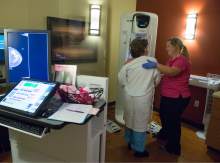This is an archived article that was published on sltrib.com in 2016, and information in the article may be outdated. It is provided only for personal research purposes and may not be reprinted.
Cindy Shepherd hasn't missed a yearly mammogram since her sister was diagnosed with breast cancer about 16 years ago.
Shepherd didn't need a reminder to keep that appointment after watching her sister go through a lumpectomy, chemotherapy and radiation. But she got one anyway five years ago when her mother, too, was diagnosed with breast cancer, the disease so advanced she had to have a double mastectomy.
In Utah, breast cancer is the leading cause of female cancer death: In 2012, there were 115.5 cases of breast cancer and 20.5 breast cancer deaths per 100,000 women, according to the state Department of Health.
But early detection — such as a mammogram — can significantly reduce that risk, the department reports.
Women should get a mammogram — an X-ray of the breast — yearly starting when they turn 40, the American College of Radiology recommends.
Shepherd, now 62 years old, was 46 when she got her first mammogram and said she now "come[s] every year, faithfully" because of her family history.
The average cost of a mammogram is $100, but it is typically covered by insurance companies for women of the appropriate age. There is help available, however, for women who find themselves among the 10.5 percent of Utahns who are uninsured: free mammogram vouchers through the Utah Cancer Control Program.
The program distributes these vouchers — about 5,000 per year — to women between the ages of 40 and 64 who meet the necessary income guidelines. Interested women can call 1-800-717-1811 to set up an appointment for a clinical breast exam, among other things, and then receive vouchers that can be used at a number of approved locations. Women must requalify for the voucher every year.
"Mammograms are the best way to detect early breast cancer and to keep women healthy," said Brenda Nelson, the program's health program specialist. "It's more of a model toward prevention as opposed to treating disease."
Shepherd's mammogram appointment this year fell in October, during Breast Cancer Awareness month, and she decided to upgrade her yearly mammogram at Davis Hospital to a three-dimensional one. A traditional mammogram is two-dimensional.
This is the second year Davis Hospital has offered a 3-D mammogram, which takes multiple 1-millimeter pictures of breast tissue. The technology can detect cancer 15 months earlier than a 2-D screening, said Autumn Mitchell, a mammography technologist at the hospital.
"With a 2-D mammogram, there's only one picture and all the breast tissue layers are piled on top of themselves and things can get missed because they're buried," Mitchell said. A 3-D mammogram, she said, allows radiologists to look at "the multiple slices like flipping through a book. If something is hiding between the layers, they can see it a whole lot easier."
The technology is about five years old, but the National Cancer Comprehensive Network recommended this year that doctors consider it as an option for annual screenings.
That's exactly what Huntsman Cancer Institute does, said Phoebe Freer, associate professor of radiology at the institute. Studies show it detects more cancers and also reduces the rate of false positives, she added.
"For the same test to be able to improve sensitivity and specificity — it's groundbreaking," Freer said. "The biggest downside is from an insurance standpoint."
The cost of this clarity varies — at Davis Hospital, it's $90 — but fewer insurance companies cover it, so many women have to pay out of pocket for this relatively new technology, Mitchell said. The state's mammogram vouchers cannot be used for a 3-D screening, Nelson said.
But Mitchell said many women are opting to pay the extra money for a 3-D image.
"We are having a waiting list for people to get this," Mitchell said. "Right now, we only have one machine that is 3-D [capable] and we have people waiting 30 to 45 minutes to get this exam."
Shepherd said opting for the 3-D screening was a no-brainer.
The new screening "makes me feel better," she said. "Any time you catch something earlier, you have more success. And with my history, the older I get, the more chances I have of getting it."
Twitter: @alexdstuckey







